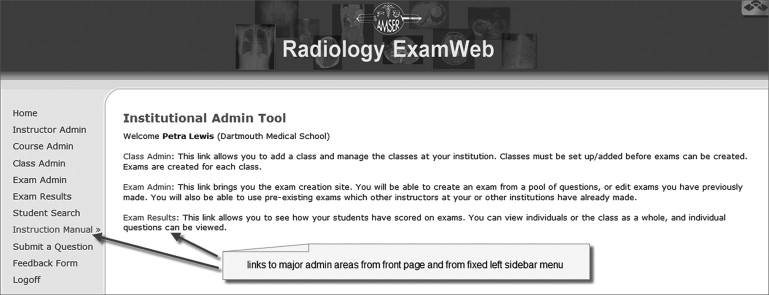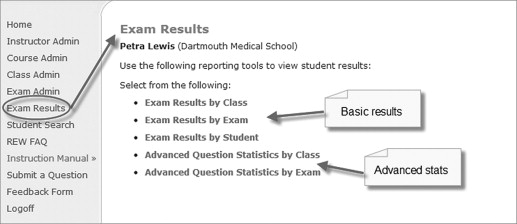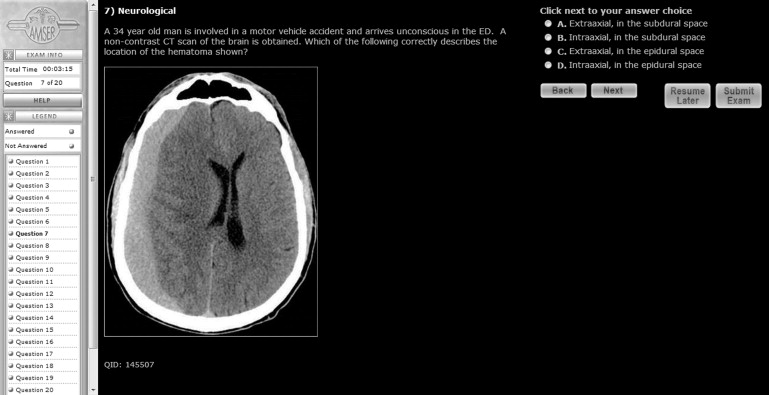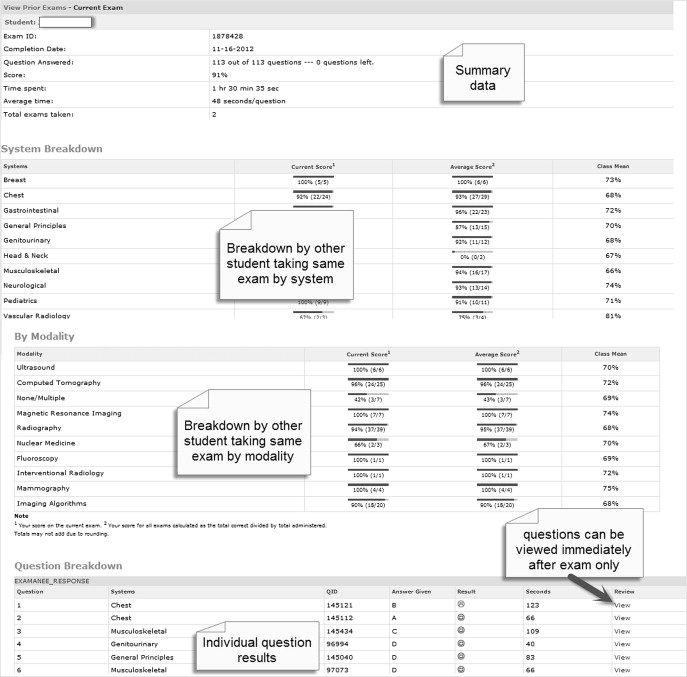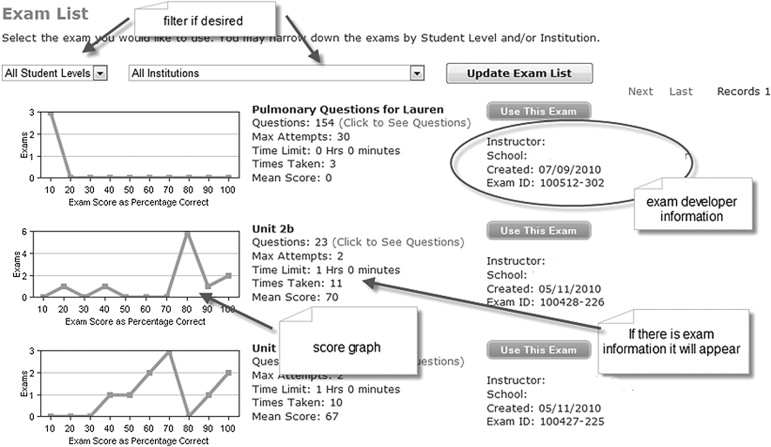Rationale and Objectives
Faculty are often limited in time, knowledge, and resources to develop efficient, effective, and valid computer-based examinations to evaluate students. Our purpose was to develop a web-based pool of standardized National Board of Medical Examiners (NBME)-format, peer-reviewed, and peer-tested questions based on the Alliance of Medical Student Educators in Radiology (AMSER) National Medical Student Curriculum to evaluate the radiologic knowledge of medical students.
Materials and Methods
Members of the AMSER Electronics Committee submitted questions they had written for their institutions and later developed a 113-question standardized examination. Questions were edited by 24 subspeciality editors and then further edited by the authors to NBME recommendations. Software was developed using commercially available software ( www.ExamWeb.com ) with extensive modifications and additions following initial deployment. Students take examinations online and receive their scores immediately. Items were validated by identifying those answered >30 times and analyzing the following: number of times deployed, number of times correctly answered, distractor-specific breakdown, difficulty level (P), and point biserial coefficient (rbi).
Results
Radiology ExamWeb (REW) is available online with 3500 registered students from 65 institutions and 1800 active questions. Instructors can create examinations or use “shared examinations” made by another instructor but enabled for other institutions to administer or modify. More than 300 shared examinations have been developed. The AMSER curriculum was converted into database format and crosschecked with question items to ensure that the question pool adequately covered the spectrum of the curriculum. An AMSER standardized examination has been developed and deployed within REW.
Conclusions
REW has provided medical student educators with the means to evaluate students in a systematic way, using a nationally edited and regularly reviewed web-based process.
Few would dispute that learning appropriate medical imaging management and interpretation skills are essential parts of medical student preparation for modern clinical practice . However, although many institutions offer either mandatory or elective radiology rotations, the content covered and pedagogy vary markedly. A key component of any curriculum includes evaluating how well medical students have acquired fundamental radiologic knowledge and concepts; this is most often assessed in the form of a standardized examination, usually in a multiple-choice format. This can also provide feedback to medical students regarding areas where they are performing well, as well as identifying areas on which they need to work . Radiology educators can use this information to evaluate their curriculum, specifically to identify the strengths and weaknesses of their rotation.
To date, student assessments have been developed locally, using a variety of soft and hard copy formats. Although computer-based formats are often the most suitable for testing image-interpretation skills, the software or necessary skills may not be available to the radiology student educator. Writing valid, appropriate test items takes training and practice. Many academic radiologists are not formally trained in test-item theory and writing techniques, and thus it may be challenging for them to develop examinations that conform to National Board of Medical Examiners (NBME) criteria and simulate existing NBME subject examinations. Although many radiology educators have their own question pools, these are often limited in content and scope, with highly variable psychometric quality. Unlike other medical student core clerkships, currently there is no NBME subject examination for radiology. This raises further the need for a national testing standard in radiology education.
Get Radiology Tree app to read full this article<
Materials and methods
Test-Item Submission and Editing
Get Radiology Tree app to read full this article<
Radiology ExamWeb (REW) Interface
Get Radiology Tree app to read full this article<
Get Radiology Tree app to read full this article<
Get Radiology Tree app to read full this article<
Get Radiology Tree app to read full this article<
Get Radiology Tree app to read full this article<
Test Development and Deployment
Get Radiology Tree app to read full this article<
Shared Examination Function
Get Radiology Tree app to read full this article<
Get Radiology Tree app to read full this article<
Test-Item Validation
Get Radiology Tree app to read full this article<
Test-Item Correlation with AMSER National Medical Student Curriculum
Get Radiology Tree app to read full this article<
The AMSER Standardized Examination
Get Radiology Tree app to read full this article<
Results
Get Radiology Tree app to read full this article<
Get Radiology Tree app to read full this article<
Get Radiology Tree app to read full this article<
Discussion
Get Radiology Tree app to read full this article<
Get Radiology Tree app to read full this article<
Get Radiology Tree app to read full this article<
Get Radiology Tree app to read full this article<
Conclusions
Get Radiology Tree app to read full this article<
Get Radiology Tree app to read full this article<
Acknowledgments
Get Radiology Tree app to read full this article<
References
1. Gunderman R.B., Siddiqui A.R., Heitkamp D.E., et. al.: The vital role of radiology in the medical school curriculum. AJR Am J Roentgenol 2003; 180: pp. 1239-1242.
2. Hammoud M.M., Barclay M.L.: Development of a web-based question database for students’ self-assessment. Acad Med 2002; 77: pp. 925.
3. Lewis P.J., Shaffer K.: Developing a national medical student curriculum in radiology. J Am Coll Radiol 2005; 2: pp. 8-11.
4. Lewis P, Shaffer K, Donovan A. AMSER national medical student curriculum in radiology. 2012. Available at: http://www.aur.org/Affiliated_Societies/amser/amser_curriculum.cfm .
5. Leaf D.E., Leo J., Smith P.R., et. al.: SOMOSAT: Utility of a web-based self-assessment tool in undergraduate medical education. Med Teach 2009; 31: pp. e211-e219.
6. Case SM, Swanson DB. Constructing written test questions for the basic and clinical sciences, third edition. 2003. Available at: http://www.nbme.org/publications/item-writing-manual.html .
7. Raymond M., Nagy P.G.: Developing and verifying the psychometric integrity of the certification examination for imaging informatics professionals. J Digit Imaging 2010; 23: pp. 241-245.
8. Samuel S., Shaffer K.: Profile of medical student teaching in radiology: Teaching methods, staff participation and rewards. Acad Radiol 2000; 7: pp. 260-263.
9. Bloom B.: Taxonomy of educational objectives: The classification of educational goals, part 2.1956.McKay PublishingNew York, NY
10. Poot J.D., Hartman M.S., Daffner R.H.: Understanding the US medical school requirements and medical students’ attitudes about radiology rotations. Acad Radiol 2012; 19: pp. 369-373.
11. NBME Subject Examination Program Information Guide. 2012. Available at: http://www.nbme.org/PDF/SubjectExams/subexaminfoguide.pdf .
